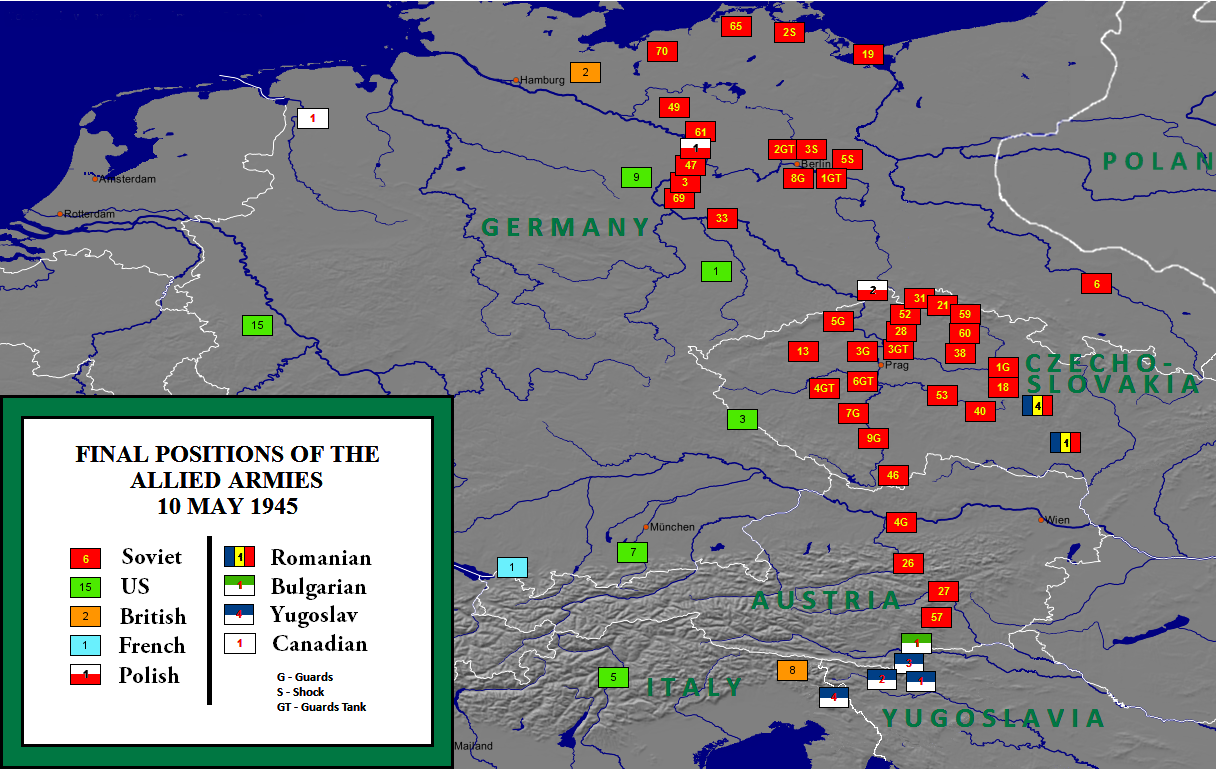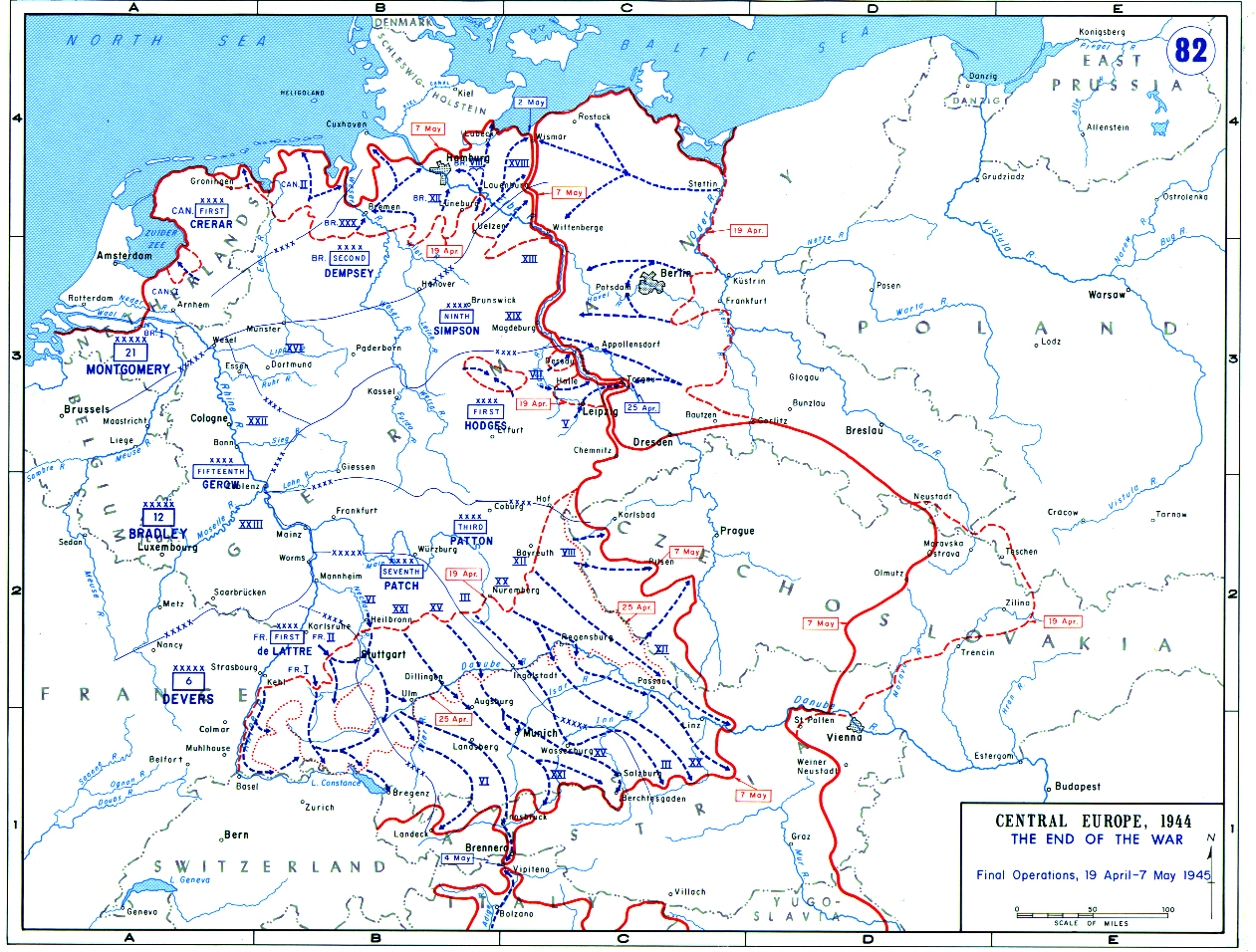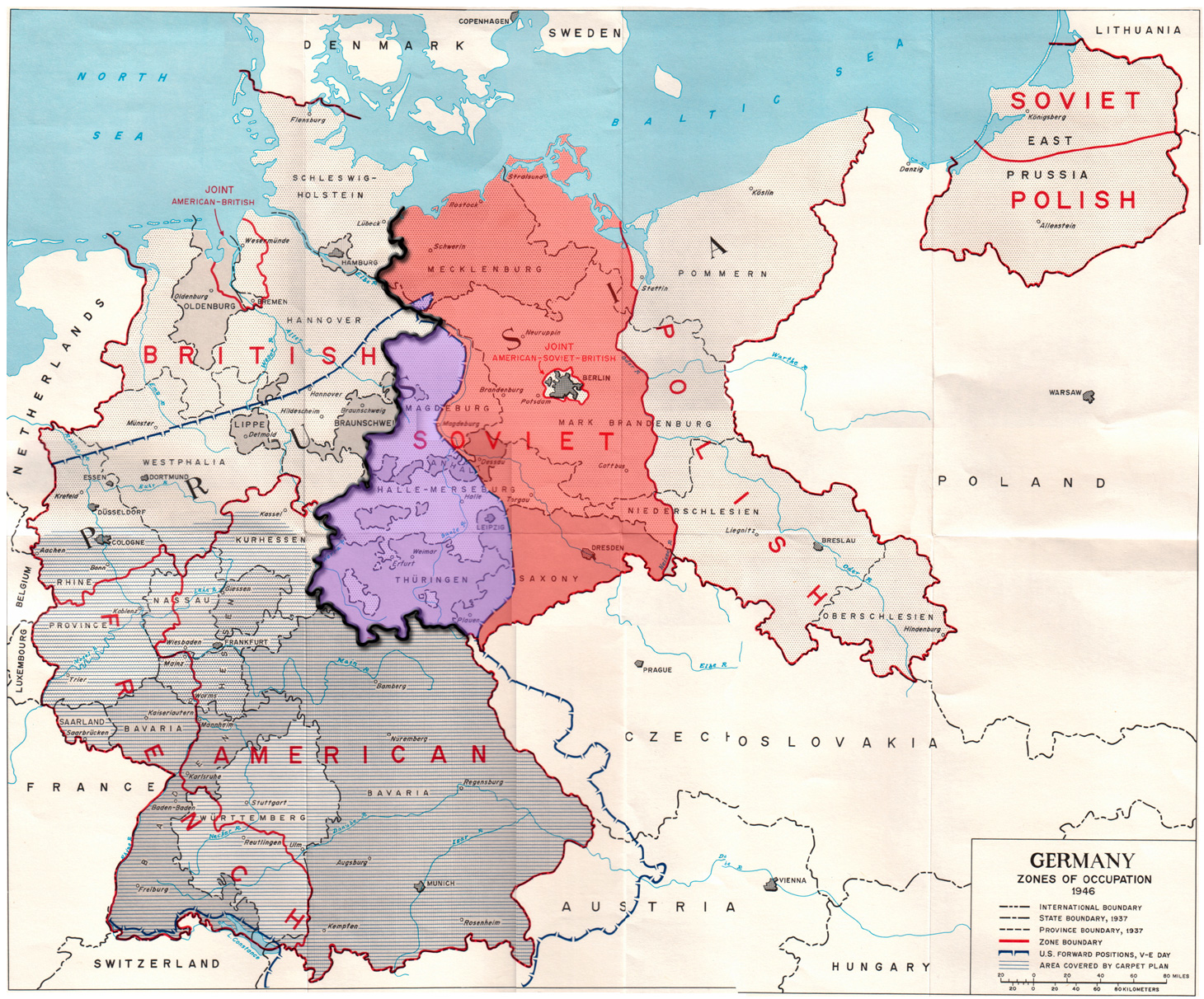Line of contact on:
[Wikipedia]
[Google]
[Amazon]

 The Line of Contact marked the farthest advance of American, British, French, and Soviet armies into German controlled territory at the end of World War II in Europe. In general a "line of contact" refers to the demarcation between two or more given armies, whether they are allied or belligerent.
The Line of Contact marked the farthest advance of American, British, French, and Soviet armies into German controlled territory at the end of World War II in Europe. In general a "line of contact" refers to the demarcation between two or more given armies, whether they are allied or belligerent.

 This contact began with the first meeting between Soviet and American forces at
This contact began with the first meeting between Soviet and American forces at
CBC Archives
CBC Radio reports on the Russian and American meeting at Torgau on May 1, 1945. World War II occupied territories Aftermath of World War II Allied occupation of Germany Borders Soviet Union–United States relations

 The Line of Contact marked the farthest advance of American, British, French, and Soviet armies into German controlled territory at the end of World War II in Europe. In general a "line of contact" refers to the demarcation between two or more given armies, whether they are allied or belligerent.
The Line of Contact marked the farthest advance of American, British, French, and Soviet armies into German controlled territory at the end of World War II in Europe. In general a "line of contact" refers to the demarcation between two or more given armies, whether they are allied or belligerent.

 This contact began with the first meeting between Soviet and American forces at
This contact began with the first meeting between Soviet and American forces at Torgau
Torgau () is a town on the banks of the Elbe in northwestern Saxony, Germany. It is the capital of the district Nordsachsen.
Outside Germany, the town is best known as where on 25 April 1945, the United States and Soviet Armies forces first ...
, near the Elbe
The Elbe (; cs, Labe ; nds, Ilv or ''Elv''; Upper and dsb, Łobjo) is one of the major rivers of Central Europe. It rises in the Giant Mountains of the northern Czech Republic before traversing much of Bohemia (western half of the Czech Re ...
river on Elbe Day
Elbe Day, April 25, 1945, is the day Soviet and American troops met at the Elbe River, near Torgau in Germany, marking an important step toward the end of World War II in Europe. This contact between the Soviets, advancing from the east, and th ...
, April 25, 1945. The line continued to form as American, British, French and Soviet forces took control of, or defeated, Nazi forces, up until the time of the May 8 unconditional surrender of Germany and beyond. This line of contact did not conform to the agreed-upon occupation zones, as stipulated in the Yalta Conference
The Yalta Conference (codenamed Argonaut), also known as the Crimea Conference, held 4–11 February 1945, was the World War II meeting of the heads of government of the United States, the United Kingdom, and the Soviet Union to discuss the post ...
. Rather, it was simply the place where the two armies met each other. The Western Allies had actually gone far beyond the Yalta agreement boundaries, in some cases up to two hundred miles past, going deep into the states of Mecklenburg
Mecklenburg (; nds, label= Low German, Mękel(n)borg ) is a historical region in northern Germany comprising the western and larger part of the federal-state Mecklenburg-Western Pomerania. The largest cities of the region are Rostock, Schweri ...
, Saxony-Anhalt
Saxony-Anhalt (german: Sachsen-Anhalt ; nds, Sassen-Anholt) is a state of Germany, bordering the states of Brandenburg, Saxony, Thuringia and Lower Saxony. It covers an area of
and has a population of 2.18 million inhabitants, making it th ...
, Saxony
Saxony (german: Sachsen ; Upper Saxon: ''Saggsn''; hsb, Sakska), officially the Free State of Saxony (german: Freistaat Sachsen, links=no ; Upper Saxon: ''Freischdaad Saggsn''; hsb, Swobodny stat Sakska, links=no), is a landlocked state of ...
, as well as Brandenburg
Brandenburg (; nds, Brannenborg; dsb, Bramborska ) is a state in the northeast of Germany bordering the states of Mecklenburg-Vorpommern, Lower Saxony, Saxony-Anhalt, and Saxony, as well as the country of Poland. With an area of 29,480 sq ...
. The capital of Mecklenburg, the city of Schwerin
Schwerin (; Mecklenburgian Low German: ''Swerin''; Latin: ''Suerina'', ''Suerinum'') is the capital and second-largest city of the northeastern German state of Mecklenburg-Vorpommern as well as of the region of Mecklenburg, after Rostock. It ...
, was captured on May 2, 1945.
The city of Leipzig
Leipzig ( , ; Upper Saxon: ) is the most populous city in the German state of Saxony. Leipzig's population of 605,407 inhabitants (1.1 million in the larger urban zone) as of 2021 places the city as Germany's eighth most populous, as ...
, in Saxony, was probably the largest of the cities captured by the Americans that were inside the areas to be later passed to the Soviets. The land of Thuringia was completely occupied by American forces. The completed line of contact between US/British/French forces and Soviet forces began at Wismar
Wismar (; Low German: ''Wismer''), officially the Hanseatic City of Wismar (''Hansestadt Wismar'') is, with around 43,000 inhabitants, the sixth-largest city of the northeastern German state of Mecklenburg-Vorpommern, and the fourth-largest city ...
on the Baltic coast and proceeded south, passing along Schwerin; Magdeburg
Magdeburg (; nds, label=Low Saxon, Meideborg ) is the capital and second-largest city of the German state Saxony-Anhalt. The city is situated at the Elbe river.
Otto I, the first Holy Roman Emperor and founder of the Archdiocese of Magdebu ...
; an area east of Leipzig; and on to the Czech town of Pilsen; and towards Linz
Linz ( , ; cs, Linec) is the capital of Upper Austria and third-largest city in Austria. In the north of the country, it is on the Danube south of the Czech border. In 2018, the population was 204,846.
In 2009, it was a European Capital ...
in Austria.
US forces generally held onto these gains within Germany until July 1945, when under orders from President Harry S. Truman
Harry S. Truman (May 8, 1884December 26, 1972) was the 33rd president of the United States, serving from 1945 to 1953. A leader of the Democratic Party, he previously served as the 34th vice president from January to April 1945 under Franklin ...
– and against the advice of British Prime Minister Winston Churchill
Sir Winston Leonard Spencer Churchill (30 November 187424 January 1965) was a British statesman, soldier, and writer who served as Prime Minister of the United Kingdom twice, from 1940 to 1945 during the Second World War, and again from ...
– the US forces withdrew to the Yalta agreement boundaries dividing Germany into occupation zones. The Soviet Union may not have allowed American, British and French forces into Berlin, which was completely under their control, if the U.S. had not honored the Yalta agreement boundaries. The German areas relinquished by American troops became part of the Soviet-dominated East Germany.
The US Army did not withdraw from western Czechoslovakia
, rue, Чеськословеньско, , yi, טשעכאסלאוואקיי,
, common_name = Czechoslovakia
, life_span = 1918–19391945–1992
, p1 = Austria-Hungary
, image_p1 ...
until December 1945, as part of an agreement removing all American and Soviet troops from the country.. US, British, French and Soviet controlled territory in Austria was incorporated into an occupation plan. Austria remained technically an occupied country by the Four Powers until 1955, when all foreign troops departed. Austria became a neutral country outside of the Iron Curtain, whereas Czechoslovakia fell inside the Iron Curtain and thus allied with the Soviet Union through the Warsaw Pact
The Warsaw Pact (WP) or Treaty of Warsaw, formally the Treaty of Friendship, Cooperation and Mutual Assistance, was a collective defense treaty signed in Warsaw, Poland, between the Soviet Union and seven other Eastern Bloc socialist repub ...
.
References
{{reflistExternal links
CBC Archives
CBC Radio reports on the Russian and American meeting at Torgau on May 1, 1945. World War II occupied territories Aftermath of World War II Allied occupation of Germany Borders Soviet Union–United States relations